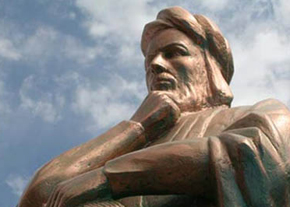
Your complimentary articles
You’ve read one of your four complimentary articles for this month.
You can read four articles free per month. To have complete access to the thousands of philosophy articles on this site, please
The Return of God?
Medieval Islam & the Nature of God
Musa Mumtaz meditates on two maverick medieval Muslim metaphysicians.
Islam’s scriptural foundation, the Quran, unequivocally asserts as its core metaphysical tenet tawhid – the uncompromising and absolute oneness of God. For the sake of human comprehension, it also seeks to define God through supreme degrees or perfections of qualities that are found in a limited way in humans. This has oftentimes caused Muslim theologians to think of God, a fundamentally non-human entity, in a somewhat human-like way. It’s a habit further reinforced by the innate tendency of humans to attribute human qualities to non-human entities, and also to clothe ineffable divinity with fathomable covers just out of complete desperation. However, this ‘humanised’ idea of God has long bothered Muslim theologians and philosophers alike.
The dilemma gave monism a place in the rich philosophical tradition of Islam. First and foremost we must understand monism in its general sense, where it may be referred to as an ‘absolute nondualism’. In general, monism says that there is some absolute single supreme reality that underlies every other phenomenon in the universe. From this basic definition, monism has been divided and applied to varying schools of thought. For instance, both the ancient Greek and Hindu philosophical traditions developed rich interpretations and adaptations of monism, which would be served unjustly if I were to try to explain them in such a short article. But among the pre-Socratics, the Pythagoreans developed one of the earliest forms of monism we still know today – an idea known as the monad. But here we shall consider an overlooked and underrepresented tradition of monism: monism in the Islamic world.
As philosophers grapple with the frustration of trying to understand the ineffable nature of reality, many prominent Muslim intellectuals have at least attempted to resolve this vexing dilemma. They include the likes of Ibn Arabi and Shihabuddin Suhrwardi – two towering intellectuals of Islamic philosophy.

Statue of Suhrwadi in Iran
Suhrwardi, born in eleventh century CE Persia, was executed on charges of heresy for his unique idea, Hikmat Al Ishraq – illuminative monism – and so his works have been marginalized and heavily scrutinized across the polarized spectrum of traditional Islam. His writings are deeply influenced by Avicena, by Neoplatonism and Aristotelianism, and ultimately prepared the way for a new mystic school of thought, Illuminationism.
The core of his idea is that reality is divine light (Nur), which weakens as it extends from God, resulting in immaterial, material, and corrupted manifestations of God, ultimately the single reality. Suhrwardi further propounds a hierarchical structure of gradations, with degrees of manifestation and intensity, and emphasizes the importance of the interplay between esoteric (Batin) and exoteric (Zahir) dimensions of reality – that is, between what can be seen and what is hidden from perception. Suhrwardi stresses the importance of direct experience and intuition, and his ideas have strong Gnostic (Irfani) underpinnings. His ideas also align with Ibn Arabi’s much-renowned but ambiguous concept of Wahdatal-Wujud, which asserts that God is the sole all-encompassing reality, and that creation is an intricate seamless web of interconnectedness with God.
Ibn Arabi, born in twelfth century CE Iberia (Spain) under Arab authority, is considered by some ‘Sheikh Al Akbar’ (‘The Greatest Sheikh’), and by others ‘Doctor Maximus’ (‘The Greatest Teacher’). His revolutionary thinking was established through his very own school of thought, the Akbarians.
Unlike Suhrwardi, Ibn Arabi does not use the idea of a metaphysical light or any other elemental possibility as an archetypal explanation. Rather, at the apex of his philosophical system is the idea of the unity of existence. This profound idea dissolves the dichotomy between the perceived world and its creator, suggesting that the universe and God are not separate entities but intertwined aspects of a unified, undivided whole, with no fundamental distinction between the creation and the creator. However, Ibn Arabi does address a difference between Mahiyya (What is it) and Wujud (it is it), along with maintaining the distinction between underlying reality and those things which exist in the world of appearances, or Mawjudat. Furthermore, Ibn Arabi introduces the concept of Barzakh, a metaphysical realm where unity and multiplicity interact, thus stressing the importance of the relational (Talluq) nature of existence, which is a seamless state of interconnectedness. His ideas are often misinterpreted as a heretical pantheism, even though Ibn Arabi establishes a clear divergence from that, saying for instance that humans are manifestations of, but not identical to, Allah.

Arabesque pattern by Paul Gregory
Ibn Arabi’s and Suhrwardi’s ideas essentially laid the groundwork for the doctrinal development of the Islamic mysticism we know as Sufism; and while their profound renditions of reality are still under thorough debate, they can nevertheless be regarded as two of the most talismanic figures of medieval Islamic thought.
© Musa Mumtaz 2024
Musa Mumtaz is an essayist and political commentator based in Lahore, Pakistan, who seeks to satisfy his white-hot passion for writing and philosophy by authoring essays and articles.









